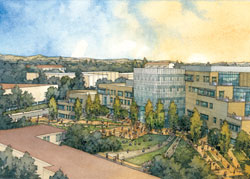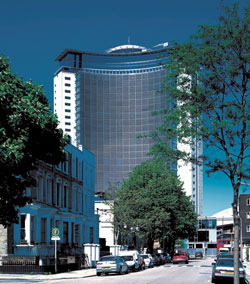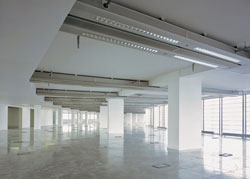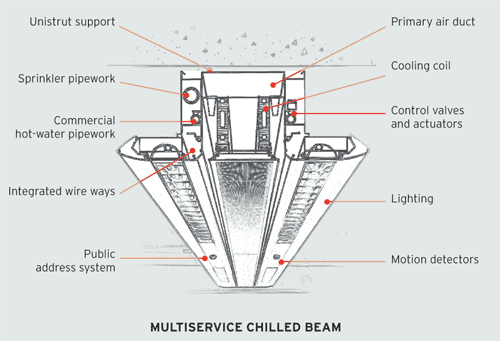An Energy-Conserving Technology From Europe Makes Inroads in the U.S.
"Chilled" heating
Active chilled beams can also be used for heating, further confusing the terminology. The same unit can be used for both heating and cooling, the only difference being the temperature of the supply water. After the air is heated by the water-warmed fan coil, discharge velocity forces it down through the space to the occupants. Warm air won't naturally drop, so passive beams, which depend on convection, are not suitable for heating.
Manufacturers recommend using warm, not hot water. The standard domestic-hot-water temperature makes discharge air too buoyant. Ceiling height is also an important factor when using "chilled" beams for heating: The higher the beam, the lower the hot-water temperature should be.
Often a chilled beam unit works alternately in cooling and heating mode. This is the case for the five-level building planned for the Center for Sciences at California Polytechnic State University in San Luis Obispo, designed by Zimmer Gunsul Frasca Architects, Los Angeles. Offices and classrooms will be tempered with natural ventilation and radiant floors. But this is not feasible in the labs, where operable windows would jeopardize the internal pressurization that keeps contaminants from a possible spill from spreading to other parts of the building.
 |
|
 |
A sciences building designed by Zimmer Gunsul Frasca for the California Polytechnic State University (above left) will have naturally ventilated offices and laboratories heated and cooled with active chilled beams. For the conversion of a hotel into the Empress State office building (left and above right), in London, Wilkinson Eyre Architects chose multiservice chilled beams (below), which combine cooling, lighting, and sprinklers, among other features, in an integrated enclosure. Images © Morely Von Sternberg (top right); Edmund Sumner (left); courtesy Trox UK (bottom); Zimmer Gunsul Frasca (top left) |
|
|
Â
The same chilled-beam fan coil is used in both heating and cooling, according to Joseph Wenisch, project manager for Oakland, California−based Rumsey Engineers, ZGF's mechanical consultant. Four pipes run to each lab: chilled-water supply and return and hot-water supply and return. At each lab's entrance, a set of valves switch between hot and cold water. Only two pipes enter the room, with water temperature determined by that room's thermostat. Because each lab is its own zone, one can be heated while another lab in the same building is simultaneously cooled. "In office buildings, it's often not cost-efficient to have a thermostat in every room," Wenisch observes. "But in a lab, there are [already] so many controls, the thermostat isn't a big thing to add."
A compact package
A third category of chilled beam is "multiservice." These units, which can be either passive or active, can also be customized to contain any number of additional building-service systems, including lighting, building management system sensors, information technology cabling, and sprinklers. Understandably, these units are more expensive than the simpler ones, but they offer several advantages. The components can be fitted optimally into the casing so the whole is more compact than the collection of parts would be. Installation scheduling is made easier and potentially more reliable.
The U.K. firms, Wilkinson Eyre Architects and mechanical engineering consultant MG Partnership, chose multiservice chilled beams for the 2003 redevelopment of the 415,000-square-foot Empress State building in West London. Their choice was influenced, in part, by the need to fast-track the conversion of the 1959 hotel into offices. In this case, the integrated services included cooling, ventilation, lighting and associated controls, speakers, and sprinkler distribution. The tower is tricorn-shaped in plan, so the variety of orientations, as well as the low ceiling heights and mix of old and new construction, required a flexible approach.
By concealing the various services within the chilled-beam unit, the architects eliminated suspended ceilings, maximized floor-to-ceiling heights, and reduced ceiling clutter. Prefabrication of the integrated units supported the accelerated construction schedule. The casing was customized to minimize its visual obtrusiveness while accommodating the needed pipes and ducts and optimizing the discharge air-flow pattern. The beams are also designed to ensure tenant flexibility. Each has its own control valve. In the future, adding a sensor and wiring back to the floor outstation can provide any new zone with individual comfort control.
With all the benefits of chilled beams, which have proved effective for nearly two decades in other parts of the world, some engineers predict that it's only a matter of time before they come into widespread acceptance in the U.S. "I have become a convert of what I envision as perhaps the next big HVAC trend, which is to minimize both fan and reheat energy," says Schultz. "What VAV systems were to the past three decades, chilled beams or similar concepts could be to the next three."










